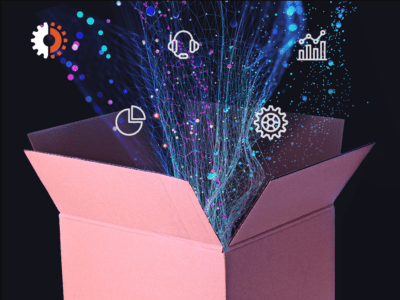Have you ever noticed that Netflix recommends new shows to you that you genuinely want to watch? Or how about when you’re sending a text message and your phone suggests the rest of the sentence that you were just about to type? Machine learning is the heartbeat behind so many of the things that make our lives easier and make the world run more smoothly. In many cases, it is so effective or natural that it goes entirely unnoticed. But what exactly is machine learning? And why is it so important to the corrugated industry? Simply put, it is the key to unlocking the trifecta of benefits that has long been the holy grail of all manufacturing goals: more production, higher quality, and lower costs.
What Is Machine Learning?
Machine Learning has been a major buzzword in nearly all industries, from robotics to search engines, healthcare to economics, and everywhere in between. But at its most fundamental level, it is the ability for computer algorithms to collect data and utilize this data to make themselves “smarter.” In other words, machine learning algorithms make predictions and decisions with ever-increasing accuracy, and without having to be told what to do or programmed to take the specific actions that they are taking.
Basically, machine learning algorithms are built to make observations and decisions based on data. For instance, a search algorithm looking for images of cats could start by being shown a picture of a cat and using this to find similar images. While this would work to some marginal degree of accuracy, the algorithm’s limited initial idea of what constitutes a cat would lead to false positive, labeling other quadrupeds with tails as cats, and false negatives with different unique-looking breeds of cats. That is where machine learning comes into play. Through machine learning, the algorithm could continue to synthesize images labeled as cats and analyze them to further refine its understanding of what distinguishes a cat from other animals. The more images of cats (and non-cats) that the algorithm views, the more and more accurate it becomes. Before long, this algorithm can begin to guess what sources are likely to produce images containing cats, and what photo settings and surroundings are likely to depict cats, and with ever-increasing accuracy, it can seemingly anticipate and label photos of cats before they are even created. The fascinating part is that a machine learning algorithm never stops learning. This means that every single bit of data that runs through the algorithm makes it smarter, infinitely, and it is even able to self-correct and weed out any biases or inaccuracies all on its own.
This principle of infinitely leveraging incoming information to make algorithms smarter applies behind the scenes in all aspects of machine learning. The key is a constant flow of data that allows the algorithm to continually refine its models. And this is where the tie-in to manufacturing, and specifically to the corrugated industry takes place.
Machine Learning for the Corrugated Industry
A corrugated operation is made up of a very intricate system of dozens of different machines, each of which has its own maintenance schedules, output rates, breakdowns and jams, changeovers, and decisions that must be made regarding each of these things. Each of these facets generates a tremendous amount of data on a daily basis, from the Flexo Folder Gluer to the Rotary Die Cutter, and other systems and processes throughout the line. Much of this information is often very challenging for humans to understand with the naked eye. If humans are using this data at all, they are usually doing so retroactively to try to diagnose the root cause of a problem after it has already occurred. But machine learning has the power to turbocharge each of these same data points and to turn them into actionable intelligence that can be used proactively for decision-making, or even to predict and prevent problems before they happen. Ultimately, users of machine learning in the corrugated industry have a major competitive advantage in maximizing profitability, optimizing resource allocation, making more accurate judgment calls, and increasing uptime.
One of the biggest obstacles to profitability and uptime within the corrugated industry is the endless cycle of machines being knocked offline for unforeseen maintenance issues. For even the most experienced operators of these machines, breakdowns seem virtually impossible to detect and they often seem to happen without warning. Following the OEM maintenance schedules for changing out parts and servicing machines is considered the best defense against unforeseen breakdowns. But even these schedules are just estimates–a component could always go bad prior to its recommended interval, or a part may still be perfectly good when the maintenance interval rolls around. In either case, the team is either spending money unnecessarily to fix a part that isn’t broken, or they are losing money due to non-scheduled downtime when a component fails ahead of its recommended maintenance interval.
With machine learning applied through Helios, an Industrial Internet of Things (IIoT) platform tailored for the corrugated industry, it is possible to know in advance when a component of a particular machine is going to need to be replaced. This means maintenance can be scheduled around planned downtime, and not left to guesswork. This works through what is called “anomaly detection,” where sensors installed in the machine make a record of anything out of the ordinary that they notice–sounds, jams, shudders, and literally anything else. Over time, anomalies can be labeled by a technician if they are an indication of something bad happening. As it gets smarter through machine learning, the IIoT platform can detect patterns of anomalies that foretell bigger issues. Helios relays this information to technicians and operators to notify them that service is likely to be needed, long before it becomes a problem. These anomalies can result in more accurate predictive maintenance recommendations for a Rotary Die Cutter, enabling technicians and supervisors to be more confident and decisive in avoiding major issues.
There is also more to machine learning than simply detecting anomalies. All usage data that is recorded and reported from each machine, for instance, the Flexo Folder Gluer analytics, can be not only aggregated and seen in real-time, but can also be analyzed historically, allowing operators and supervisors to make data-driven decisions regarding quality and fully optimized operations.
What Can the Machine Learning Capabilities of Helios Do for Your Operation?
Machine learning is seamlessly integrated into Helios, the IIoT platform specially engineered for the corrugated industry, which gives users a competitive advantage through both unprecedented monitoring capabilities, and advanced anomaly detection and predictive analytics. Helios’ corrugated manufacturing monitoring system serves like x-ray goggles that can equip decision-makers with real-time corrugated machine monitoring and curated insight and data that can be used to make decisions for resource allocation, avoiding bottlenecks, maximizing output, and ultimately increasing productivity and profitability. But it does not stop at the machines–the comprehensive Helios corrugated IIoT platform can even automate parts orders, turning all facets of maintenance into a proactive approach rather than a reactive approach.
With the machine learning power of Helios, your operation will see an overall improvement to general processes, minimized downtime, and maximized operational efficiency.


 Data Security in the IIoT Age
Data Security in the IIoT Age